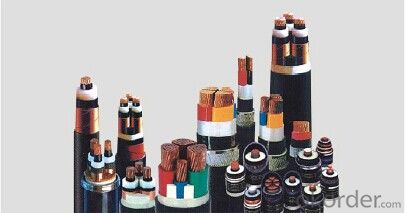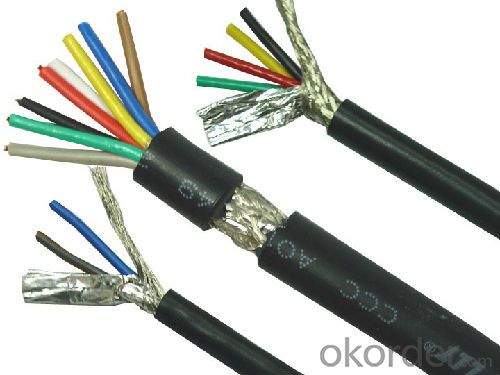Packaging & Delivery
| Packaging Details: | Wooden drums or as customers' demand |
|---|---|
| Delivery Detail: | 7-30 days or as customers' demand |
OKorder Service Pledge
OKorder Financial Service
You Might Also Like
Place of Origin: Henan, China (Mainland)
Insulation Material: PVCModel Number: BV
Type: Low Voltage
Application: Construction
Conductor Material: Copper
Jacket: Bare
International Standard: IEC 60502,AS,BS,CE,CSA,DIN,ISO,NFC,SGS,ASTM,GOST,or as requested
Type: Single Core
Rated Voltage: 450/750V
| Packaging Details: | Wooden drums or as customers' demand |
|---|---|
| Delivery Detail: | 7-30 days or as customers' demand |
building Wire
1.ISO CCC certificate
2.13 years professional experience
3.Factory price.
4.Rated voltage: 450/750
450/750V Flexible Stranded Copper PVC Insulated building Wire
Application
This product is suitable for fixed laying in power plant with AC.
Product Standard
GB/T5023-2008
JB8734-1998.
Datas and Information
| Nominal sectional area mm2 | Conductor No/Dia. mm | Nominal Insulated thick mm | Max overall Dia. mm | Condcutor Resistance at 20 | Min insulated resistance at 70MΩ/km | Weight Kg/km | ||
| Cu | Al | Cu | Al | |||||
| 1.5 | 1/1.38 | 0.7 | 3.3 | 12.1 | - | 0.011 | 19.2 | - |
| 1.5 | 7/0.52 | 0.7 | 3.5 | 12.1 | - | 0.010 | 20.6 | - |
| 2.5 | 1/1.78 | 0.8 | 3.9 | 7.41 | 11.8 | 0.010 | 30.8 | 15.0 |
| 4 | 1/2.25 | 0.8 | 4.4 | 4.61 | 7.39 | 0.0085 | 45.5 | 21.0 |
| 6 | 1/2.76 | 0.8 | 4.9 | 3.08 | 4.91 | 0.0070 | 65.0 | 29.0 |
| 10 | 7/1.35 | 1.0 | 7.0 | 1.83 | 3.08 | 0.0065 | 110.0 | 52.0 |
| 16 | 7/1.70 | 1.0 | 8.0 | 1.15 | 1.91 | 0.0050 | 170.0 | 70.0 |
| 25 | 7/2.14 | 1.2 | 10.0 | 0.727 | 1.20 | 0.0050 | 270.0 | 110.0 |
| 35 | 7/2.52 | 1.2 | 11.5 | 0.524 | 0.868 | 0.0040 | 364.0 | 150.0 |
| 50 | 19/1.78 | 1.4 | 13.0 | 0.387 | 0.641 | 0.0045 | 500.0 | 200.0 |
| 70 | 19/2.14 | 1.4 | 15.0 | 0.268 | 0.443 | 0.0035 | 688.0 | 269.0 |
| 95 | 19/2.52 | 1.6 | 17.5 | 0.193 | 0.320 | 0.0035 | 953.0 | 360.0 |
| 120 | 37/2.03 | 1.6 | 19.0 | 0.153 | 0.253 | 0.0032 | 1168.0 | 449.0 |
| 150 | 37/2.25 | 1.8 | 21.0 | 0.124 | 0.206 | 0.0032 | 1466.0 | 551.0 |
| 185 | 37/2.52 | 2.0 | 32.5 | 0.099 | 0.164 | 0.0032 | 1808.0 | 668.0 |
Flexible wire
| Nominal sectional area mm2 | Conductor No/Dia. mm | Nominal Insulated thick mm | Max overall Dia. mm | Condcutor Resistance at 20 | Min insulated resistance at 70MΩ/km | Weight Kg/km |
| 2.5 | 9/0.41 | 0.8 | 4.2 | 7.41 | 0.011 | 33.0 |
| 4 | 19/0.52 | 0.8 | 4.8 | 4.61 | 0.009 | 48.0 |
| 6 | 19/0.64 | 0.8 | 5.6 | 3.08 | 0.0084 | 68.0 |
| 10 | 49/0.52 | 1.0 | 7.6 | 1.83 | 0.0072 | 115.0 |
| 16 | 49/0.64 | 1.0 | 8.8 | 1.15 | 0.0062 | 176.0 |
| 25 | 98/0.58 | 1.2 | 11.0 | 0.727 | 0.0058 | 272.0 |
| 35 | 133/0.58 | 1.2 | 12.5 | 0.524 | 0.0052 | 384.0 |
| 50 | 133/0.68 | 1.4 | 16.5 | 0.387 | 0.0051 | 510.0 |
| 70 | 189/0.68 | 1.4 | 16.5 | 0.268 | 0.0045 | 714.0 |
| 95 | 259/0.68 | 1. | 19.5 | 0.139 | 0.0035 | 965.0 |
| 120 | 259/0.76 | 1.8 | 22.0 | 0.153 | 0.0032 | 1210.0 |
| 150 | 259/0.85 | 1.8 | 25.0 | 0.124 | 0.0032 |
Picture


Send your message to us
OKorder Service Pledge
OKorder Financial Service
Similar products
Hot products
Hot Searches